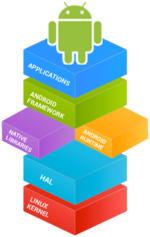Hardware

The main hardware platform for Android is ARM (the ARMv7 and ARMv8-A architectures), with x86 and x86-64 architectures also officially supported in later versions of Android. The unofficial Android-x86 project provided support for x86 architectures ahead of the official support. The ARMv5TE and MIPS32/64 architectures were also historically supported but removed in later Android releases. Since 2012, Android devices with Intel processors began to appear, including phones and tablets. While gaining support for 64-bit platforms, Android was first made to run on 64-bit x86 and then on ARM64. Since Android 5.0 "Lollipop", 64-bit variants of all platforms are supported in addition to the 32-bit variants.
Requirements for the minimum amount of RAM for devices running Android 7.1 range from in practice 2 GB for best hardware, down to 1 GB for the most common screen, to absolute minimum 512 MB for the lowest spec 32-bit smartphone. The recommendation for Android 4.4 is to have at least 512 MB of RAM, while for "low RAM" devices 340 MB is the required minimum amount that does not include memory dedicated to various hardware components such as the baseband processor. Android 4.4 requires a 32-bit ARMv7, MIPS or x86 architecture processor (latter two through unofficial ports), together with an OpenGL ES 2.0 compatible graphics processing unit (GPU). Android supports OpenGL ES 1.1, 2.0, 3.0, 3.1 and 3.2 and since Android 7.0 Vulkan (and version 1.1 available for some devices). Some applications may explicitly require a certain version of the OpenGL ES, and suitable GPU hardware is required to run such applications.
Android devices incorporate many optional hardware components, including still or video cameras, GPS, orientation sensors, dedicated gaming controls, accelerometers, gyroscopes, barometers, magnetometers, proximity sensors, pressure sensors, thermometers, and touchscreens. Some hardware components are not required, but became standard in certain classes of devices, such as smartphones, and additional requirements apply if they are present. Some other hardware was initially required, but those requirements have been relaxed or eliminated altogether. For example, as Android was developed initially as a phone OS, hardware such as microphones were required, while over time the phone function became optional. Android used to require an autofocus camera, which was relaxed to a fixed-focus camera if present at all, since the camera was dropped as a requirement entirely when Android started to be used on set-top boxes.
In addition to running on smartphones and tablets, several vendors run Android natively on regular PC hardware with a keyboard and mouse. In addition to their availability on commercially available hardware, similar PC hardware-friendly versions of Android are freely available from the Android-x86 project, including customized Android 4.4. Using the Android emulator that is part of the Android SDK, or third-party emulators, Android can also run non-natively on x86 architectures. Chinese companies are building a PC and mobile operating system, based on Android, to "compete directly with Microsoft Windows and Google Android". The Chinese Academy of Engineering noted that "more than a dozen" companies were customising Android following a Chinese ban on the use of Windows 8 on government PCs.
Comments
Post a Comment